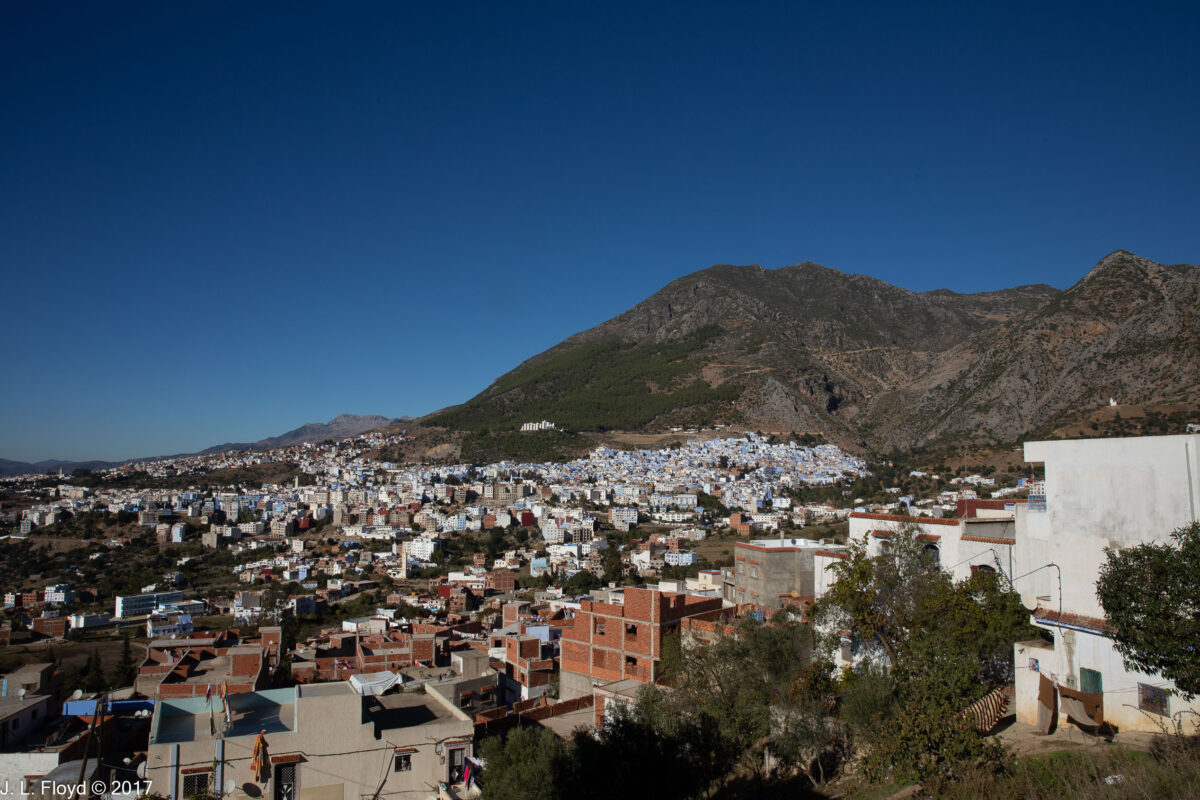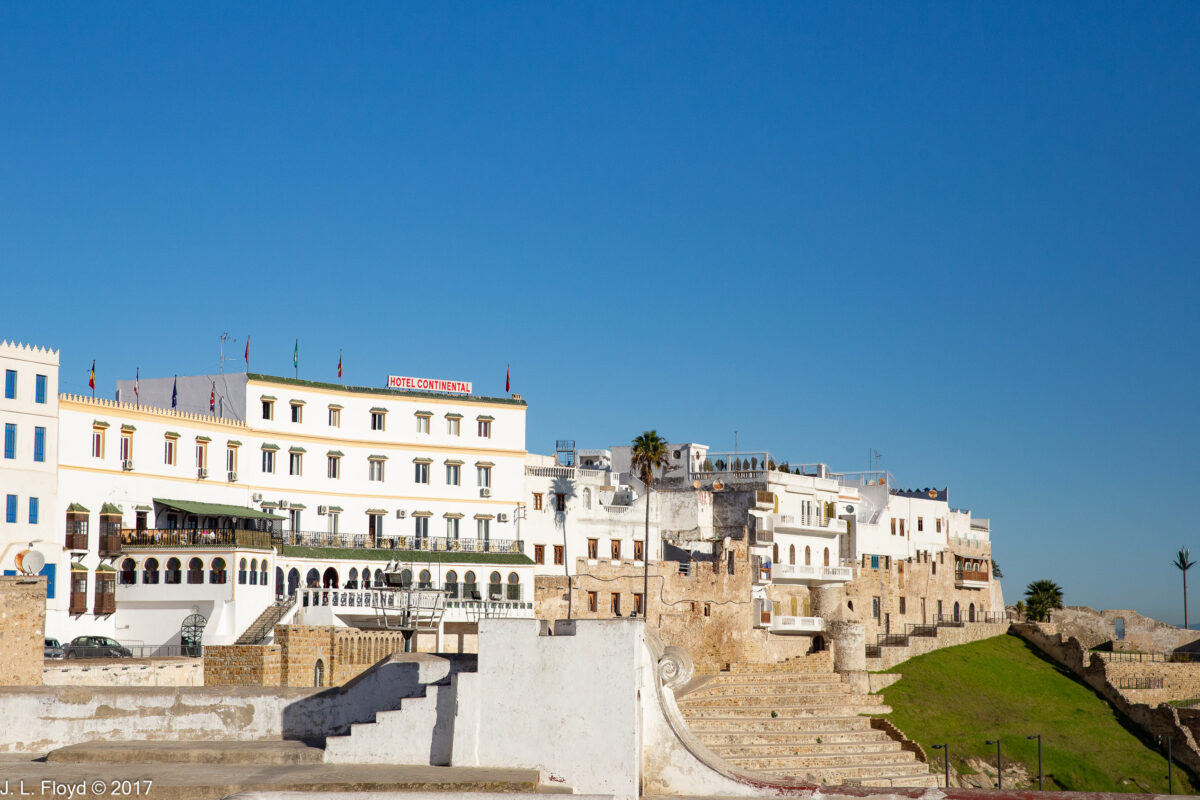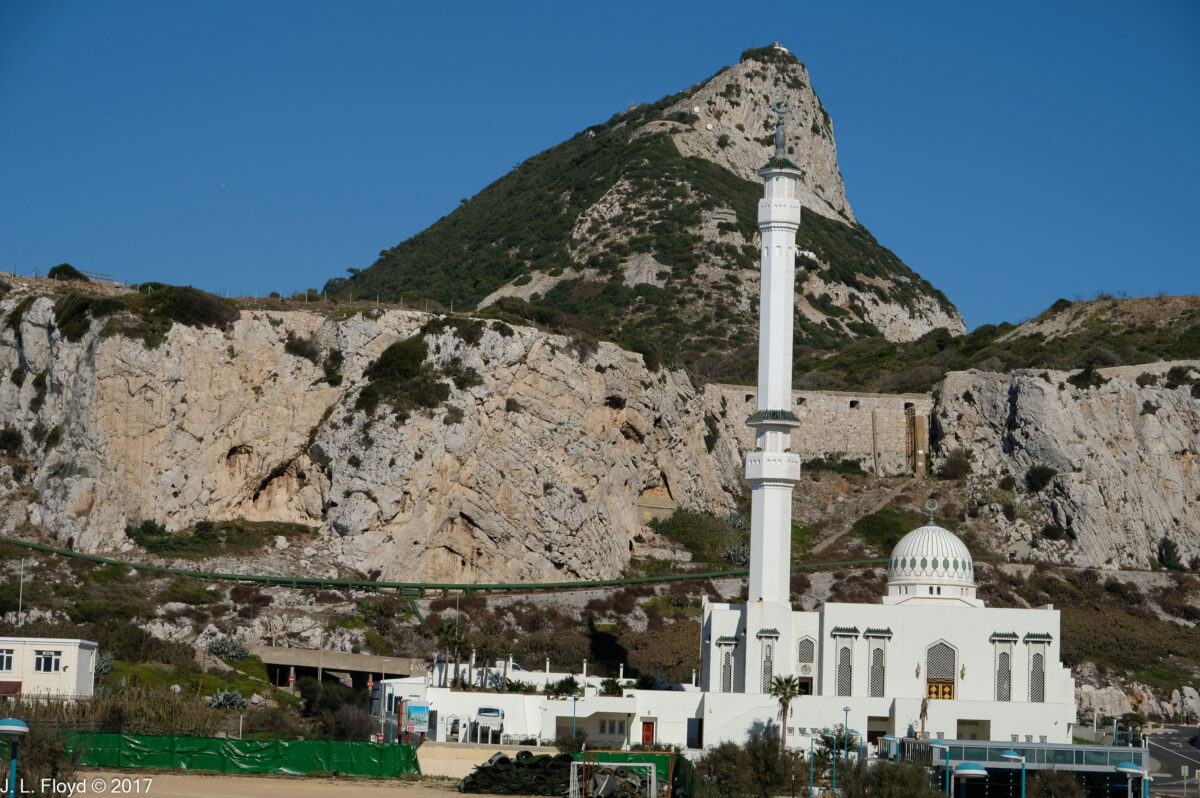On the afternoon of November 11, 2017, Veterans’ Day in the United States (a holiday which I favor, being a veteran), our Go-Ahead tour group arrived in Chefchaouen, known as the Blue City because many of its buildings are painted in that color. It is usually referred to simply as Chaouen. There are several theories as to how blue came to be the theme color of Chaouen, one being that the color has a special spiritual significance for the locals, another that it is repellent to mosquitoes, and a third, which seems most probable to me, that it was adopted in recent times as way of attracting tourists.
Chaouen is not one of the most ancient cities of Morocco. In the fifteenth century, following the completion of the Reconquista in Portugal, the Portuguese began to take the offensive against the Moors in North Africa. They took a number of cities in northern Morocco, most notably Ceuta and Tangier, and one of the local mujahideen built a small kasbah (fortress) in the Rif Mountains as a stronghold of resistance to the invaders. Over the following years a city grew up around the fortress, its population augmented by Moriscos and Jews expelled from Spain after the fall of Granada in 1492. The influx of immigrants from the Iberian peninsula was the source of a strong Andalusi-Granadan influence on the local culture, manifested most visibly in local residential architecture.
Portuguese imperial ambitions in Morocco were dashed by the Battle of Alcazarquivir in 1578, in which the King of Portugal was killed, ending his dynasty and leading to the takeover of Portugal by Philip II of Spain in 1580. Spanish rule of Portugal and its colonial empire continued until 1540, when the Portuguese rebelled and regained their independence.
Fast forward to the 19th century, when the French were establishing their colonial empire in North Africa. By the end of that century, the Spanish had lost the last of their overseas domains – Cuba and the Philippines – in the Spanish-American War, and were looking for some sort of compensation in order to keep some vestige of their standing among the European powers. Morocco seemed a likely place since so much of it was up for grabs anyway. At the same time, France and Britain took pity on the Spanish and agreed to let them have a few crumbs from the imperial banquet in the form of small slices of Morocco at its northern and southern ends. The arrangement was sealed by the creation of a dual French and Spanish protectorate over the country in 1912. Spain’s slice in the north included the city of Chaouen. The heritage of the Spanish occupation there is most visible in the street names and commemorative plaques, which are generally in Arabic and Spanish (though often in English as well).
The Berber tribes of the Rif Mountains, where Chaouen is located, did not accept Spanish domination passively, and under a capable leader named Abd el-Krim, they rose in revolt, inflicting severe defeats on the Spanish forces. Abd el-Krim established a short-lived government, the Rif Republic, which lasted from 1921 until 1926, when the Spanish finally crushed it with much help from the French. In 1925, at the height of the Rif War, Chaouen was bombarded by the Lafayette Escadrille, a squadron of American mercenary pilots in the service of France.
Francisco Franco rose to prominence during the Rif War, and later, in 1936, launched his uprising against the Spanish Republic from Morocco. The Spanish protectorate in Morocco continued until 1956, when both French and Spanish protectorates were dissolved and merged into the newly independent Kingdom of Morocco. However, Spain did retain the cities of Ceuta and Melilla on the Mediterranean coast.
In the post-World War II era, especially since the 1960s, Chaouen became a popular tourist destination. At first this was primarily associated with the production of cannabis in the Rif; Chaouen emerged as a major hub of cannabis tourism. Cultivated in Morocco for centuries, cannabis was outlawed by King Mohammed V when the country gained independence in 1956. But it was tolerated unofficially to some extent because of its traditional usage by the local population and also because it provided an important source of income for poor farmers of the Rif Mountains, where few other crops can be grown profitably. In recent years, the recognition of the economic value of cannabis has led to its partial decriminalization: in 2021 Morocco declared it legal for medicinal, cosmetic and industrial, though not for recreational purposes. By 2024 Morocco had become the world’s foremost supplier of cannabis. However, I don’t remember seeing any evidence of cannabis commerce in Chaouen, and since I myself am not a cannabis consumer, I didn’t look for it.
Our bus had deposited us in the newer part of Chaouen, through which we had to make our way on foot to the main area of interest, the Chaouen Medina. It was immediately apparent why it was called the Blue City. Not everything was blue, but many of the major structures, such as the wall of the cemetery on Boulevard Hassan II and the local high school, were painted in a bright and deep blue that was quite distinctive, even flamboyant.
Entering the Medina through one of its main gates, the Bab El-Ain, we emerged on the Uta el-Hammam, the main square of the Medina, so named because there is a hammam (public bathhouse) in the northwest corner. There we were able to view the Grand Mosque of Chaouen. Its date of construction is uncertain but is thought to have been in the late 15th or early 16th centuries, though its distinctive octagonal minaret was erected later, sometime in the 17th. As the main mosque of Chaouen, it served as an assembly point where the local notables gathered to make obeisance to the Sultan and where the Sultan’s proclamations were read out to the populace. For me its most striking architectural feature consisted of the blind arches, filled with green-and-white tile inlays, on the sides of what I took to be the prayer hall. The minaret also incorporates blind arches, three tiers of them, with square panels inlaid with zellij tiles on the top tier; for some reason we failed to capture photos of the minaret, but it can be seen here.
We spent some time roaming through the backstreets and alleys of the Medina, where we found ourselves immersed in a sea of blue. Along with Chuck and Elouise Mattox, Sandie and I soon got lost in the maze.
When we finally extricated ourselves, we came out near the main entrance of the Kasbah, the old fortress which was the foundational structure of Chaouen. Next to the entrance there is a historic house which contains some of the archaeological and ethnographic exhibits of the Kasbah, which is now a museum. We did not explore the museum; I think it was closed on the day we were there. On the steps leading to the entrance were piled various household effects such as mattresses, other furniture and crockery. Apparently it was moving day for someone, but who that might be, and whether they were moving into the Kasbah, out of it, or into or out of one of the nearby structures, I was unable to figure out.
Of the native inhabitants of Chaouen, the most memorable for us were the cats. There were a fair number of them inhabiting the Medina, and they seemed to enjoy some sort of privileged or at least well-tolerated status. They mostly looked well-fed and groomed, and they strolled casually around the Uta el-Hammam, without fear or reproach except when tourists crowded in on them; but they seemed to have little trouble coping with that. They even lounged on tabletops in restaurants, which would have been a no-no in an American city.
We continued to roam around the Uta el-Hammam until it was time for lunch. Much of the square was occupied by the souk or bazaar, which was unsurprisingly devoted mostly to tourist-oriented shops and stalls. The wares on display consisted mostly of textiles, clothing, leather goods and ceramics. I was intrigued by some of the offerings, but time was growing short and anyway I had heard that it was advisable to wait until we got to the great entrepot of Fes, our next stop, before splurging on souvenirs.
Every place has its eccentrics, and while wandering around Uta el-Hammam I encountered an old fellow in a Moroccan djellaba (a loose, full-length robe-like garment with a hood) with an unkempt appearance and a glowering, wild-eyed mien. He roamed the crowd, haranguing tourists and locals alike, in what language I don’t know – I could not tell whether it was Arabic or Berber, but it certainly wasn’t French, Spanish or English. His counterpart in an American city would have been carrying a sign that said “Repent! The End of the World is Nigh!” I gave him a few dirhams (Moroccan currency), which he accepted, but that did not soften his tone or his hostile glare, and he went on his way, muttering and grumbling unintelligibly.
We enjoyed our long-awaited and much-needed lunch at Chez Hicham, where we were seated in an upstairs gallery with a superb view of the Uta el-Hammam and the landscape beyond the city. After dining we enjoyed a few more minutes of leisure in the square, enduring the rantings of the aforementioned madman, before it was time to begin the trek back to the bus.
Back in the bus, we began the long journey to Fes. It was soon interrupted by a brief stop just outside Chaouen, at a location which provided a great panoramic overview of the city; I took advantage of the opportunity to catch a few nice shots not only of the town, but also of the immediate surroundings, which included a walled villa with a cute little dog sleeping in its courtyard, oblivious to all the commotion on the highway passing by.



